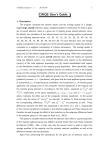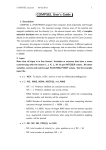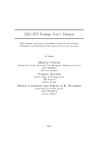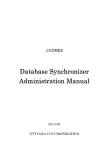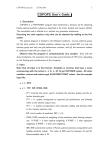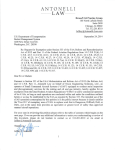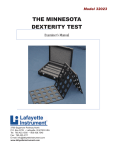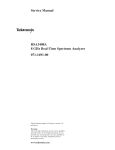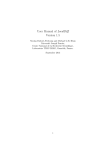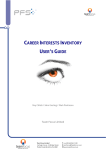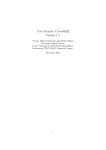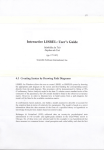Download TROFSS User's Guide
Transcript
TROFSS program v. 2 10/12/2006 1 TROFSS User’s Guide 1. Description TROFSS is a FORTRAN77 program that determines a point-wise approximation to the PARETO SURFACE in SINGLE-STAGE PROBATIONARY or NON-PROBATIONARY selection decision when the applicant group is a MIXTURE OF MINORITY AND MAJORITY APPLICANTS such that both the objectives of selection quality and adverse impact are of importance. Selection quality can refer to either the predictor composite validity, the globally standardized expected criterion performance or the utility per selected applicant. The method of normal boundary intersection is used to determine Pareto points that are evenly spread on the solution surface and for each point the corresponding values of the selection rate (in case of a probationary selection decision), the global criterion cutoff value and the predictor weights are computed. At present, the program is limited to problems with no more than 10 selection predictors, a single majority and a single minority group and no more than 3 criterion behaviour dimensions. The effect sizes are defined with respect to the minority applicant group (i.e., the first group) such that this group has all effect size values equal to zero. The computation of the adverse impact ratio assumes that the last subgroup is the majority group. The present program computes solutions over the entire set of feasible predictor weights. Predictor weights are feasible if (a) at least one weight is positive and (b) all weights are non-negative and at least equal to a given, non-negative value. The FORTRAN77 program to implement the solution uses (a) routines from the SLATEC FORTRAN77 library (Fong et al., 1993), (b) an extension of the algorithm presented by Genz (2001) to compute multivariate probabilities, (c) the algorithm AS249 from the STATLIB software library and (d) bits of optimization code. To implement the program, the user must specify a number of input parameter values. These are detailed below. Among other things, the setting of the problem parameters provides the opportunity to address probationary or non-probationary selections, to constrain the minimum and maximum hiring rate in the probationary period and to choose between either the composite validity, the globally standardized expected criterion score of the selected candidates or the selection utility as the selection quality criterion. To derive the expected utility, the return of the corresponding random selection must be computed first. This can be done using the program with certain specific values for some of the input parameters (see below). 2. Assumptional Basis The calculations are based on the assumption that the predictor and (eventually) the criterion dimensions have a joint multivariate normal distribution with the same vari- TROFSS program v. 2 10/12/2006 2 ance/covariance matrix but different mean vectors in the different applicant populations. Given this assumption it is, without further restrictions, understood that the joint distribution of the predictors and the criterion dimensions is standard multivariate normal in the reference applicant population (i.e., the minority applicant population). 3. Input Observe that all input is in free format: Variables or vectores that have a name commencing with the letters I, J, K, L, M, N get INTEGER values. All other variables, vectors and matrices get FLOATING POINT values. See the example input file. • # 1: NC, IFIXCR, IFIB, IFIP, (VMAMI(I), I = 1, NGR) – NC: number of criterion dimensions (NC ≤ 3) – IFIXCR: The value of the composite criterion behaviour cutoff is estimated (IFIXCR = 0) or given (IFIXCR = 1). For probationary selection set IFIXCR = 0. For non-probationary selection, set IFIXCR = 1 – IFIB: Set IFIB = 0 in case of a non-probationary selection. Set IFIB = 1 in case of a probationary selection for which the initial hiring rate is bounded from below and above (see below) – IFIP: Set IFIP = 0 in case of a non-probationary selection. Set IFIP = 1 in case of a probationary selection for which the initial hiring rate is fixed at a given value – (VMAMI(I), I = 1, 2): VMAMI(I) indicates the proportion of the total applicant group that comes from candidate population I Observe that VMAMI(1) + VMAMI(2) must be equal to 1 • # 2: NPRED, IUTIL, IBN – NPRED: the number of selection predictors. NPRED less or equal to 10. – IUTIL: If IUTIL = 0, the globally standardized expected criterion score of the selected applicants is used as the selection quality criterion. If IUTIL = 1, selection quality corresponds to the selection utility per selected applicant. To obtain the utility in monetary value, the utility must be multiplied by the value of TFACC (see below). If IUTIL = -1, then the validity of the composite predictor represents the selection quality objective. – IBN: the number of points used to approximate the Pareto surface. Values between 20 and 30 are usually adequate. The program always generated a total of IBN + 1 points of the Pareto surface. If IBN = 1, only the two TROFSS program v. 2 10/12/2006 3 extreme points of the Pareto surface are determined. IBN = 0 may only be used in combination with IUTIL = 1. • # 3: XSEL, VALLOW – XSEL: Required proportion of successfully selected applicants – VALLOW: Predictor weights must at least be equal to the value of VALLOW. Normally, VALLOW = 0. • # 4: OPTIONAL: only if IFIB is different from zero. The value of XOB. XOB indicates the lower bound on the global selection ratio for probationary selections • # 5: OPTIONAL: only if IFIB is different from zero. The value XUP. XUP indicates the upper bound on the global selection ratio for probationary selections • # 6 and following: OPTIONAL: only if IFIP is different from zero. The value of XOB. XOB indicates the global selection ratio for probationary selections • # 7 and following: For each applicant group K (with K = 1, 2), DIFC(K,I) (with I = 1, NC), DIFP(K,I) (with I =1, NPRED). The element DIFC(K,I) indicates the effect size value of criterion dimension I for applicant group K, whereas DIFP(K,I) corresponds to the effect size value of predictor I for the same candidate group. The elements of the first rows of DIFC and DIFP are all zero because the first applicant group is the reference group. The elements of the second row pertain to the majority applicant group that is used to determine the adverse impact ratios. • # 8: WC(I) (with I = 1, NC). Vector of length NC with the pre-assigned weights of the criterion dimensions • # 9 and following: CC(I,J) (with both I and J = 1, NC): NC × NC matrix of criterion dimension intercorrelations. Only the strict upper triangle of the correlationmatrix! So, if NC = 1, then CC(1,1) must not be specified. • # 10 and following: PC(I,J) (with both I and J = 1, NPRED). Matrix of predictor correlations. Only the strict upper triangle of the correlationmatrix! • # 11 and following: PV(I,J) (with I = 1, NC and J = 1, NPRED): matrix of predictor validities. Thus PV(I,J) indicates the validity of predictor J with respect to criterion dimension I. • # 12: OPTIONAL: only if IUTIL = 1. The values of NAPPL, RETRAN, SIY, XMUY, TFACC TROFSS program v. 2 10/12/2006 4 – NAPPL: Total number of applicants – RETRAN. RETRAN indicates the the payoff of the corresponding random selection. To obtain the value of RETRAN, run the program with values of 1, 0 and 0. for IUTIL, IBN and RETRAN, respectively to compute the payoff of a corresponding selection with a single, non-valid (i.e., predictor validity is zero for all criteria) predictor with zero effect size. – SIY: Money valued standard deviation of the criterion behaviour in the entire applicant group for 1 time period – XMUY: Money valued mean criterion behaviour in the entire applicant population for 1 time period – TFACC: equate TFACC to XMUY • # 13: OPTIONAL: only if IUTIL = 1. The values of RYR, TS – RYR: Correlation between rated (aggregate or composite) criterion and money valued criterion behaviour – TS: Number of time periods that a successfully selected employee will remain on the job. • # 14: OPTIONAL: only if IUTIL = 1. The values of TRCO, SECO – TRCO: Training costs per selected applicant – SECO: Separation costs per unsuccessfully selected applicant • # 15: OPTIONAL: only if IUTIL = 1. The values of TECO(I) (with I = 1, NPRED): Vector of length NPRED with the predictor costs per applicant 4. Sample Input File Important: in preparing the input file, use a simple text editor such as Notepad, Wordpad or any other standard ASCII producing editor. DO NOT USE TEXT PROCESSING PROGRAMS SUCH AS MS-WORD or WORDPERFECT. Also, when saving the input file in Notepad, use the option “All Files” in the “Save as type” box. When saving in Wordpad, use the “Text Document-MS-DOS Format” option in the “Save as type” box, and be aware that Wordpad has the nasty habit of adding the extension .txt to the file name that you specify. Thus, with Wordpad, if you specify the name of the input file as “MINPUT”, the file will in fact be saved as “MINPUT.TXT”; and this is the name that you have to use in the command to run the present programs. Here is a sample input file, for the trofss program. TROFSS program v. 2 2 1 0 0 4 0 20 0.15 0. 0.00 0. 0.210 0.130 3.000 1.000 0.170 0.240 0.000 0.120 0.160 0.510 0.300 0.300 0.160 0.260 5 10/12/2006 0.25 0. 1.000 0.75 0. 0.230 0. 0.090 0. 0.330 0.190 0.180 0.200 0.280 0.250 5. Running the Program Suppose you copied the executable source of the program to the d:ssel directory on your machine. In that case, the input file must also be saved in the d:ssel directory. Next, to run the program, you have to open an MS-DOS Command window. The way to do this varies from one operating system (i.e., Windows 95, 98, NT a.s.o.) to the other, and you should use your local “HELP” button when in doubt about this feature. In the MS-DOS Command window you type d:, followed by RETURN or ENTER, and your computer will return the D:\> command prompt. Next, you type cd ssel after the D:\> command prompt, again followed by RETURN or ENTER, and your computer will respond with the D:\ssel> command prompt. Now, you can execute the program by typing trofss < minput > moutput where “minput” is the name of the input file and “moutput” is the name of the output file. At the end of the execution, the PC will return the command prompt D:\ssel>. You can then inspect the output by editing the output file with either Notepad, Wordpad or any other simple editor program. 6. Sample Output Program execution starts on 4/ 9/2006 at 16:59: 3 THE PRESENT CODE IS TO BE USED FOR RESEARCH PURPOSES ONLY THE PROGRAM AUTOMATICALLY ABORTS AFTER SOME TIME AND A NEW VERSION OF THE CODE MUST BE DOWNLOADED ++++++++++++ + TROFSS + +++++++++++++ Computation of the PARETO SURFACE in SINGLE-STAGE PROBATIONARY or NON-PROBATIONARY selection decision when the applicant group is a MIXTURE OF MINORITY AND MAJORITY APPLICANTS such that both the objectives of selection quality and adverse impact are of importance. Selection quality can refer to TROFSS program v. 2 10/12/2006 6 either the globally standardized expected criterion performance or the utility per selected applicant. The method of normal boundary intersection is used to determine Pareto points that are evenly spread on the solution surface and for each point the corresponding values of the selection rate (in case of a probationary selection decision), the global criterion cutoff value and the predictor weights are computed. Predictor weights obey a variance constraint. At present, the program is limited to problems with no more than 10 selection predictors, a single majority and a single minority group and no more than 5 criterion behaviour dimensions. Program written by Wilfried De Corte, Ghent University, Belgium The program uses routines from the Slatec library (see http://www.geocities.com/Athens/Olympus/5564), a couple of algorithms from StatLib (see http://lib.stat.cmu.edu/apstat/), and some (adapted) code from Genz to evaluate multivariate normal probabilities (cf. http://www.math.wsu.edu/math/faculty/genz/homepage). PROBLEM SPECIFICATION Problem relates to a non-probationary selection Quality Objective is Expected Criterion Score Number of criterion dimensions: 2 Number of applicant groups: 2 Proportional representation applicant groups: 0.250 0.750 Overall proportion of (successful) selectees: 0.150 Number of available predictors: 4 Weights used to combine the individual criterion dimensions to the composite criterion are: 3.000 1.000 Correlation matrix of the criterion dimensions: Criterion 1 1.000 0.170 Criterion 2 0.170 1.000 Correlation matrix of the predictors: Predictor 1 1.000 0.240 0.000 0.190 Predictor 2 0.240 1.000 0.120 0.160 Predictor 3 0.000 0.120 1.000 0.510 Predictor 4 0.190 0.160 0.510 1.000 Validities of the predictors (columns) with respect to the criterion dimensions (rows): Criterion 1 0.300 0.300 0.180 0.280 Criterion 2 0.160 0.260 0.200 0.250 Effect sizes selection predictors (First group is base) Group 1: 0.000 0.000 0.000 0.000 Group 2: 1.000 0.230 0.090 0.330 TROFSS program v. 2 7 10/12/2006 Effect sizes criterion dimensions (First group is base) Group 1: 0.000 0.000 Group 2: 0.210 0.130 Fixed cutoff value overall criterion dimension is Predictor weights are optimized -7.500 Computations start from random initialized values DETAILS SELECTED PARETO-OPTIMAL TRADE-OFFS First line: number of Pareto-optimal trade-off, Value AI and Quality, and Relative Importance AI Objective Second line: Selection ratio and Unit Sum Predictor Weights NOTE: In case of probationary selection the AI value corresponds to the adverse impact after the probationary period, whereas the selection ratio is before the probationary period. 1 2 3 4 5 6 7 8 9 10 11 12 13 14 15 16 17 AI Quality 0.150 AI Quality 0.150 AI Quality 0.150 AI Quality 0.150 AI Quality 0.150 AI Quality 0.150 AI Quality 0.150 AI Quality 0.150 AI Quality 0.150 AI Quality 0.150 AI Quality 0.150 AI Quality 0.150 AI Quality 0.150 AI Quality 0.150 AI Quality 0.150 AI Quality 0.150 AI Quality 0.868 0.000 0.000 0.850 0.000 0.056 0.833 0.000 0.110 0.815 0.000 0.162 0.798 0.000 0.213 0.780 0.000 0.264 0.762 0.000 0.318 0.743 0.000 0.375 0.724 0.000 0.442 0.703 0.000 0.536 0.678 0.000 0.546 0.651 0.000 0.536 0.623 0.000 0.526 0.592 0.000 0.512 0.554 0.021 0.493 0.515 0.053 0.474 0.476 0.350 1.000 0.380 0.944 0.410 0.890 0.439 0.838 0.468 0.787 0.498 0.736 0.527 0.682 0.556 0.625 0.584 0.558 0.611 0.464 0.635 0.403 0.658 0.347 0.680 0.283 0.699 0.199 0.713 0.162 0.727 0.157 0.740 Rel. Import. 0.000 Rel. Import. 0.000 Rel. Import. 0.000 Rel. Import. 0.000 Rel. Import. 0.000 Rel. Import. 0.000 Rel. Import. 0.000 Rel. Import. 0.000 Rel. Import. 0.000 Rel. Import. 0.000 Rel. Import. 0.052 Rel. Import. 0.116 Rel. Import. 0.191 Rel. Import. 0.289 Rel. Import. 0.323 Rel. Import. 0.316 Rel. Import. AI 1.000 AI 0.628 AI 0.627 AI 0.626 AI 0.624 AI 0.620 AI 0.614 AI 0.604 AI 0.583 AI 0.513 AI 0.477 AI 0.456 AI 0.419 AI 0.329 AI 0.262 AI 0.253 AI 0.241 TROFSS program v. 2 18 19 20 21 0.150 AI Quality 0.150 AI Quality 0.150 AI Quality 0.150 AI Quality 0.150 8 10/12/2006 0.087 0.454 0.435 0.123 0.432 0.393 0.164 0.407 0.348 0.213 0.378 0.296 0.277 0.339 CPU TIME IN SECONDS 0.151 0.752 0.146 0.763 0.139 0.772 0.131 0.777 0.120 0.308 Rel. Import. 0.300 Rel. Import. 0.290 Rel. Import. 0.279 Rel. Import. 0.264 AI 0.222 AI 0.192 AI 0.136 AI 0.000 2.88 7. Description of Output At present, the output provides input for plots of the solution using the R package. 8. Acknowledgement When the user reports results obtained by the present program, due reference should be made to De Corte (2006) and De Corte, Lievens & Sackett (2007). 11. References De Corte, W. (2006). TROFSS User’s Guide. De Corte, W., Lievens, F. & Sackett, P. (2007). Combining predictors to achieve optimal trade-offs between selection quality and adverse impact. Journal of Applied Psychology (accepted) Fong, K. W., Jefferson, T. H., Suyehiro, & Walton, L. (1993). Guide to the SLATEC common mathematical library (http://www.netlib.org/slatec/).








